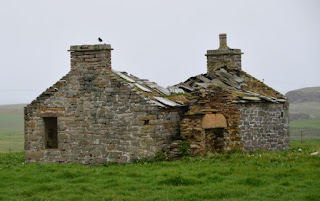Kirkwall is the largest town in the Orkney
Islands...Orkney is made up 70 islands of which 20 are inhabited and in the
northern end of Scotland. We met our driver, Simon Van Tromp, of Tours by
Locals and headed south from Kirkwall along the coast near the First and Second
World War Naval Base of Scapa Flow, crossing the Churchill Barriers that were
constructed by Italian POWs. From a distance, we could see the town of Stenness
and across the bay to the hills of Hoy and the Bay of Ire. Driving through an
area of rich farmland and rolling hills fringed by cliffs, we encountered some
of the places that comprise the Heart of Neolithic Orkney UNESCO World Heritage
Site. Our first stop was the Standing Stones of Stenness, one of the earliest
stone circles in Britain...the surviving stones are enormous standing up to 6 meters
in height. We made our way to the Ring of Brodgar, a stone circle 130 meters
across surrounded by a rock cut ditch...where we walked among the 27 remaining
stones. The next stop was Yesnaby Cliffs, a 400-million-year-old lake bed.
Before making our way to Skara Brae, Heart of Neolithic Orkney...we made a stop
for refreshments, shopping and to warm up at the Orkney Brewery in the village
of Quoyloo. Next, we made our way to Orkney's Neolithic village and the
best-preserved settlement of its kind in Northern Europe, Skara Brae...Skara
Brae is about 5,000 years old, a well-preserved settlement whose stone walls,
passageways and stone furnishings, such as beds and dressers, survived to the
present day. Lying beside the pretty, sandy crescent of the Bay of Skaill, this
Stone Age settlement was totally buried under sand for thousands of years,
until it was suddenly revealed during a fierce storm in 1850...Among the
fascinating relics found here are tools, beads, pottery and whalebone
artifacts. Looking across the village, it is easy to imagine how it looked all
those centuries ago, and gives a unique insight into how our ancient ancestors
lived. The hardship of life in Skara Brae contrasts sharply with Orkney's
finest manor house, Skaill House, located nearby. A powerful bishop built
Skaill House in 1620, never knowing what lie below the estate. Returning to Kirkwall,
we passed the Maeshowe Burial Chamber, an example of a Neolithic architectural
genius...the chamber was designed to allow the setting sun at the winter
solstice to shine up the passageway and illuminate the chamber. Passing through
the quaint village of Finnstown, we came upon the Highland Distillery the
oldest in Orkney just as they were loading barrels of whiskey for aging. From
here, we returned to Kirkwall for some free time to enjoy this pretty town, the
town is dominated by the magnificent 12th-century, red sandstone Cathedral of
St Magnus...built in 1137, this was a beautiful church of Romanesque design and
known locally as the Light of the North.
It is the finest medieval building in northern Scotland...across the
street the remains of the Bishops and Earls Palaces, an example of French
renaissance architecture...walking along the narrow, winding streets, it was
evident, the area has changed very little over the centuries...of course we
tired the famous Orkney ice cream and fudge. The rain and cold did not put a
damper on our touring or visiting the sites the Orkney Islands has to
offer...we had a very accommodating knowledgeable guide and we thoroughly enjoyed
our time in this rugged part of Scotland.




















































No comments:
Post a Comment